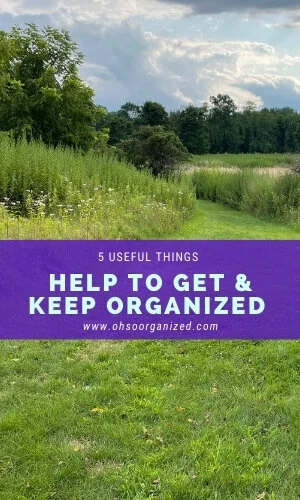The newest installment (v32) of the “What’s Interesting?” feature is here with my latest finds informing, educating, and relating to organizing and life balance. Included are unique, inspiring mindfulness-related discoveries, which reflect this month’s blog theme.
You are a generous, warm, and engaged group. I am deeply appreciative and grateful for your presence, positive energy, and contributions to this community. I look forward to your participation and additions to the collection I’ve sourced.
What do you find interesting?
What’s Interesting? – 5 Best Mindfulness-Related Discoveries
1. Interesting Read – Mindful Living
Do you want to introduce more mindfulness into your life? In The Mindful Day – Practical Ways to Find Focus, Calm, and Joy From Morning to Evening, Laurie Cameron, mindfulness teacher and founder of PurposeBlue, shares fifty simple strategies backed by science and experience. Laurie says,
“… practicing mindfulness is about learning, bit by bit, how to train your attention to stay in the present instead of ruminating over the past or racing into the future.”
The book’s five sections highlight ways to start, seize, enjoy, enrich, and end the day. Laurie suggests infusing mindful awareness into breathing, showering, writing, listening, walking, touching, and other regular activities. She says, “Awareness amplifies the senses. When you live through your senses, you get a rich direct experience instead of a removed experience. You are feeling in the body instead of being lost in your head.”
2. Interesting Trend – Mindful Break
Has FOLO (Fear of Logging Off) taken over your life? While disconnecting from our digital devices is an ongoing challenge, the pandemic added a new layer. In the past year and a half, our work/life boundaries blurred dramatically as the expectation for constant availability increased. For many people working remotely, their anxiety escalated when they stepped away from their computers for even 20 minutes. If they didn’t instantly respond to an email, they felt their colleagues might think they were too lax.
To help with FOLO, Julie Morgenstern, a time management and productivity expert, suggests creating boundaries by taking short breaks throughout the day and informing your colleagues when you do. Pandemic or not, developing a mindful habit of engaging in technology breaks during the day will help you restore your energy, gain perspective, and be more productive. Disconnect and introduce mindfully eating lunch, having a snack, stretching your body, or getting some fresh air. Change your habits and say goodbye to FOLO.
3. Interesting Article – Mindful Organizing
Are you struggling with getting organized? If so, you’re not alone. In a recent Huffington Post article, “The Biggest Home Organizing Mistakes People Make,” Caroline Bologna interviews Professional Organizers, including my colleagues Seana Turner, Lisa Zaslow, Regina Lark, and me. The piece sheds light on everyday things that can go wrong during the organizing process. Typical challenges include purchasing containers before decluttering, being overly ambitious, not paring down, failing to maintain systems, and delaying requests for help. By mindfully considering what not to do, you will get organized with greater ease and success.
“Instead of creating mini-projects and taking small steps, people get overly ambitious and try to do too much at once.”
4. Interesting Season – Mindful Time
As the kids go back to school, temperatures cool, and the trees change colors, let the changes all around inspire you to let go, de-stress, and get organized. Fall is a fantastic season to set your organizing goals, declutter the extraneous, and create the calm you deserve at home. Change is possible, especially with support. If you are struggling, enlist help from a compassionate and non-judgmental friend, family member, or professional organizer like me. I’m ready to help. Discover how virtual organizing can work for you and why my clients love it so much. Let’s talk. Call 914-271-5673 or email me at linda@ohsoorganized.com.
5. Interesting Thought – Mindful Pause
Have you experienced the “Oh” moment? During this mindful pause, you may think to yourself or say aloud, “Oh.” You are aware of feelings, sightings, sensations, sounds, or scents. You stop to acknowledge what you are experiencing. When you slow down, you can focus on where you are, what you’re doing, and what you’re noticing. The next time you see a fall leaf that changed color, feel lighter as you let go of clutter, or experience joy at the sound of your loved one’s voice, pause to be present for your “Oh” mindfulness moment.
What are your interesting mindfulness discoveries? Which of these resonate with you? I’d love to hear your thoughts. I invite you to join the conversation.
















